|
Speedometers
and Gauges
By Sean Elliott
Pictures and picture links thanks to Jon
Rogers, Al Brass
and Frank Berg
Which
is correct for your
jeep?
There
are five known brands of speedometer found in the WW 2
jeep and these are Waltham, King Seeley, Stewart Warner, Autolite,
MotoMeter . Within the brands are early and later types. While some of the
information on this page is obtained from original manuals and
documentation
some has been obtained purely through observation and may be proven
incorrect
at a later date. All attempts have been made to keep this information
as
accurate as possible and as new information proving to be correct is
found I
will update the pages. Where exact dates are unknown I have used Early,
Mid.
and Late terms for the production times.
Early ……. Jan to
April
Mid ………May to Aug
Late
…….. Sept to Dec
Feb to March 1942
Stewart
Warner or King Seeley speedometer with long needle.
Stewart
Warner paint can lid Fuel (long needle), Oil, Amp and Temp gauges.
March 1942 to Jan 1943
Stewart
Warner or King Seeley speedometer with long needle.
Stewart
Warner Fuel (long needle) and Amp gauges. (block
F at bottom of Amp face)
Stewart
Warner or AutoLite Oil and Temp gauges.
Jan 1943 to April 1943
Stewart
Warner or King Seeley speedometer with short needle.
Stewart
Warner Fuel (long needle), Amp, Oil and Temp gauges.
(block
F at bottom of Amp face)
Feb 1943 to Aug 1943
Stewart
Warner or King Seeley speedometer with short needle.
Waltham
speedometer with long needle.
Stewart
Warner Fuel (long needle. short needle from April),
Amp, Oil and Temp gauges.
(block
F at bottom of Amp face)
Aug 1943 to April 1944
Stewart
Warner, King Seeley or
Waltham
speedometer with short needle.
Stewart
Warner Fuel (short needle), Amp, Oil and Temp gauges.
(block
F at bottom of Amp face)
April 1944 to end of production
Stewart
Warner, King Seeley or
Waltham
speedometer with short needle.
Stewart
Warner Fuel (short needle), Amp, Oil and Temp gauges.
(block
F or Stewart Warner 403398 made in
USA
at bottom of Amp face)
Ford
GPW
Some
early to mid 1942 script Gpw’s had 65 mph
speedometers until the change was made to bring them in line with the
MB speed
limit of 60 mph. Some GPW’s as late as Mid. 1944 however still had
Maximum 65
mph stamped data plates. My April 1944 GPW, being one of them.
I
have only seen King Seeley speedometers
with a 65 mph face and all of these have the early long needle. Both
the King
Seeley and Stewart Warner were used throughout production of the GPW.
WALTHAM
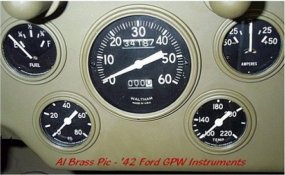 It
is now a known fact that from late Feb. 1943 to end of
production the Waltham speedometer was used in the GPW. This It
is now a known fact that from late Feb. 1943 to end of
production the Waltham speedometer was used in the GPW. This
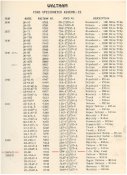
information comes
straight out of an original 1946 dated Waltham service manual.
While
they were used
from Feb 43 onwards they were not used exclusively and actually only
seem to
have been used in small numbers. The Waltham is a fairly rare speedo
and not
all that easy to find. It is also one of the better made speedos and
the speedo
I will be using in my 44 GPW restoration.
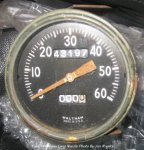 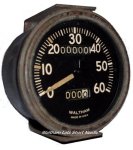 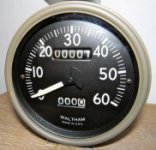
STEWART
WARNER
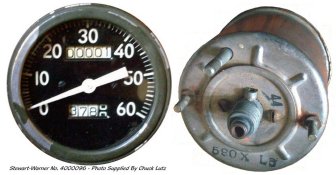 There are two types
of Stewart Warner speedometers used during 1942. There are two types
of Stewart Warner speedometers used during 1942.
The first type S-W had larger black
numbers on white wheels for the odometer and trip meter. The numbers
and
increment lines on the face are printed closer to the outer edge of the
face
and the model No. 400096 is printed at the top edge of the face. The
trip meter
reset arm is knurled at the end and does not have the screw on knob
like the
second type. This speedo was only used in very early 42. This type of Stewart Warner long needle were used with "paint can" gauges  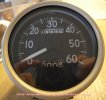
The
model number is printed on the back of the case along with the date of
manufacture code.
The
model number is 590 AD and the date code is a letter and number printed
after that. The letter is the year and the number is the month.The fifth rib has been found on:
N2 - M9 - L11 - L6 - K7
The
K4 (April 1942) in Navarre's photo only has FOUR ribs. I also have one
like that with FOUR ribs that also has a K4 date code on it....this
might indicate that between April and July 1942 the case design was
changed.
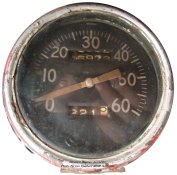 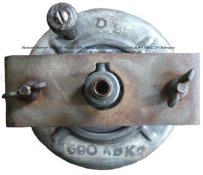 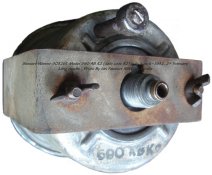 590
AD K4 is 1942 April 590
AD K4 is 1942 April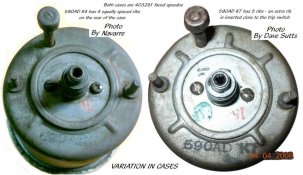
590
AD L10 is 1943 October
590
AD M9 is 1944 September
590
AD N12 is 1945 December Variations in cases 4 and 5 rib.
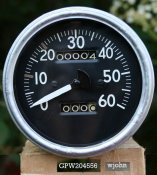
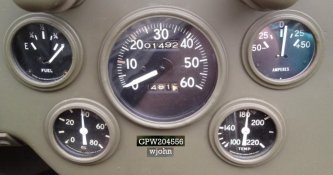
The second type S-W
has smaller white numbers on black wheels and are a different font to
the early
type. The
numbers and increment lines on the face are printed further
away from
the outer edge or closer to the center of the face. These numbers on
the face
are squared off at the ends where the early type is rounded. The model
number
printed at the top edge of the face is 403261.
Both type S-W speedometers go to 60
mph only and the
second type can have either the longer needle or the short half moon
type
needle. The longer needle version was used in early GPW’s till around
Jan 43
while the shorter needle version being used till end of production.
KING
SEELEY
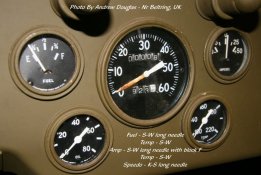 There
are three types of K-S speedometers. Early and Late
production. The first very early 42 only type has a 65 mph face with
the model
No. KS-40363 BN printed at the top. The second type has a 60 mph face
with the
model No. KS-40363-C printed at the top. The third type also has a 60
mph face
with the model No. KS-40363-N printed at the top. All three
speedometers have
white numbers on black wheels and all number fonts are the same.With
the second
and third types the early version up to Jan-Feb 43 has the long needle
and the
later 43 onwards ones have the short half moon needle. The King Seeley
was more
commonly found throughout production and is a well made speedo equal to
the
Waltham. King-Seeley were also fitted to Willys MB's There
are three types of K-S speedometers. Early and Late
production. The first very early 42 only type has a 65 mph face with
the model
No. KS-40363 BN printed at the top. The second type has a 60 mph face
with the
model No. KS-40363-C printed at the top. The third type also has a 60
mph face
with the model No. KS-40363-N printed at the top. All three
speedometers have
white numbers on black wheels and all number fonts are the same.With
the second
and third types the early version up to Jan-Feb 43 has the long needle
and the
later 43 onwards ones have the short half moon needle. The King Seeley
was more
commonly found throughout production and is a well made speedo equal to
the
Waltham. King-Seeley were also fitted to Willys MB's
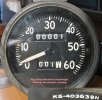
The second type has a 60 mph face with the model
No. KS-40363-C printed at the top and either a long or short needle. 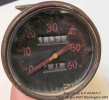 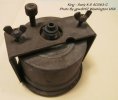 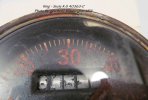
The
third type also has 60 mph face with the model No. KS-40363-N printed at
the top. All three speedometers have white numbers on black wheels and
all number fonts are the same. The early type has the long needle. The
mid type can have either the long needle or the short half moon needle.
The late type has the half moon needle. The late type also has a
different case to the other two. The case shape is the same but it has a
screw on plate added to the back of it.   
AC
The
AC was not a factory fitted speedometer and would be
incorrect for a factory restoration. They were however used in other
military
vehicles of the time such as the DUKW and were often fitted to the jeep
by
service personnel as a replacement. The AC was used as a replacement
for the
non-incremented slat grill speedometers. They are therefore correct for
a motor
pool class restoration.
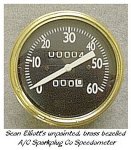 Brass bezel
AC Brass bezel
AC
FORD
GAUGES
All Ford GPW gauges after the paint
can lid style had a
squarer steel bezel than the MB ones. The early and mid 1942 gauges had
rubber
seals and from late 1942 to end of production cork and paper seals were
used
due to the rubber shortage.
FUEL
GAUGE
Two
types of fuel gauge were used. Both are identical
except for the needle. During 1942 a long straight needle was used
which was
square cut at the end. From Feb.1943 onwards the needle was shorter
with a
slightly rounded end. Both had Stewart Warner made in U.S.A printed
around the
bottom edge of the face.
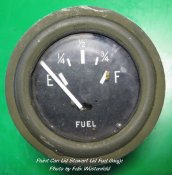 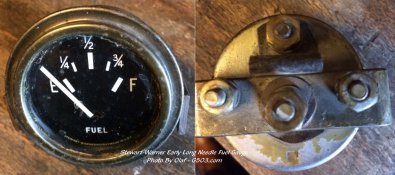 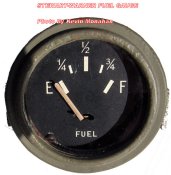
Very Early Paint Can Lid ..................Early long needle ........................... Feb. 43 onwards short needle
AMPERES GAUGE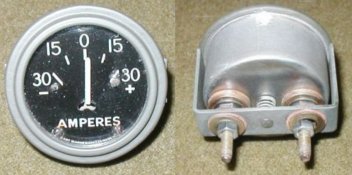 The
amperes gauge is a 50-25-0-25-50 gauge with a long,
straight, square end needle. It has a block F printed at the bottom of
the
face. The 30-15-0-15-30 amp gauge in the photo
on the right is a S-W gauge and has
Stewart
Warner printed around the bottom edge of the face. The needle is also
much
shorter but it is yet to be proven whether or not this is a GPW gauge.
The short needle AMP Gauge shown below may be a very late ( '45) gauge.
The standard gauge is the Long Needle gauge shown on the lower right.
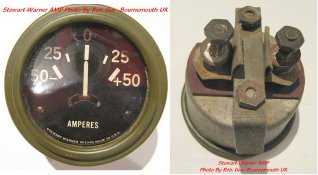 
OIL
GAUGE
The
oil gauge is a 0 to 80 Psi gauge and has Stewart
Warner made in U.S.A printed around the bottom edge of the face.
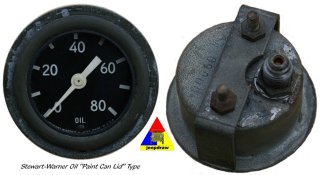 
TEMPERATURE
GAUGE
The temperature gauge is a 100 to
220 Deg. Gauge and has
Stewart Warner made in U.S.A printed around the bottom edge of the
face. It
also has a flat steel binding around the capillary tube.
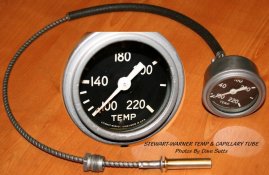 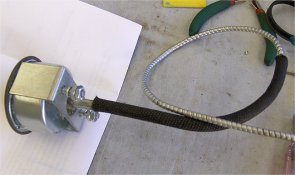
Click photo to enlarge
Ford
"Paint can lid" style
These
were used in very
early GPW’s. The faces are identical to the later style with the
exception of
the Amp gauge which has Stewart Warner made in USA printed around the
bottom of
the face unlike the later Amp gauge which just had a block F. Evidence
I have
found seems to show these were only used in the early GPW’s with the MB
type
chassis.
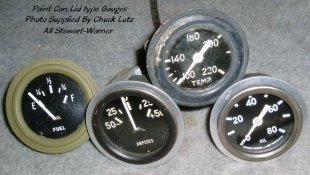 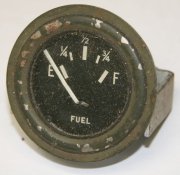
Photos
thanks to Ron Fitzpatrick
of G503
Willys
MB
The MB only used Autolite
and
Motometer-meter speedos.
The
slat grill MB
originally came with Autolite speedometers that did not have the
increment
lines between the numbers but the Ordnance Dept. later issued an order
that
these be replaced with incremented speedometers. This is why Slatties
are often
found with any of the six jeep speedos in them. Contrary to popular
belief they
did not come with Brass bezels.
After the Slat Grill all MB’s had
Motometer speedos fitted, this is also true of King-Seeley which were also a standard fitting on MB's.
Both Autolite and Motormeter are 60 mph speedometers.
Autolite
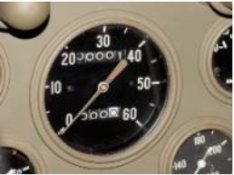 The Autolite speedo was used in the
Slat Grill MB
only and is a
different looking speedo
to all the others. It has a bezel shaped the same as the Autolite
gauges found
in all MB’s, the number font is the same style as the gauges, the
needle is
thin and pointed and is the same shape as the gauge needles and the
face did
not have the 1 mph increment marks. The Autolite speedo was used in the
Slat Grill MB
only and is a
different looking speedo
to all the others. It has a bezel shaped the same as the Autolite
gauges found
in all MB’s, the number font is the same style as the gauges, the
needle is
thin and pointed and is the same shape as the gauge needles and the
face did
not have the 1 mph increment marks.
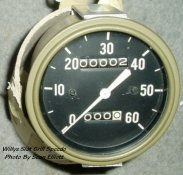 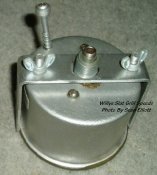 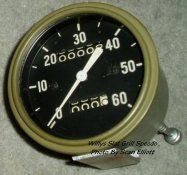
To the right is an
original picture taken at Holabird testing facility and is the dash of
MB-128875. It has a GAS gauge,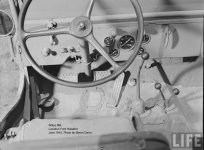
50 Amp gauge and
the Autolite 2nd style speedometer fitted. As can clearly be seen
the odometer has less than 10 miles registered on it.
Moto-Meter
Moto-Meter
speedometers were used
throughout production of
the MB jeep. There are two known types of Moto-meter speedometer. The
first
type was used throughout 1942 and early 1943. The indents around the
cutouts
for the odometer and trip meter are the same and the trip meter reset
arm has a
felt dust seal around it, which is held close to the case by the arm
spring.
The early ones had the long style needle.
.
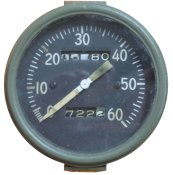
The later type used from early 1943
onwards has an
identical face to the early type except for the indent at the top of
the trip
meter cutout, which is much larger. The trip meter arm also has a
knurled
locking nut fitted to it, which locks the arm to prevent it from being
pushed
in to reset the trip meter. The later style needle is the shorter half
moon
style.
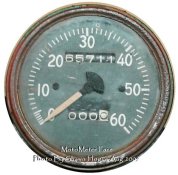 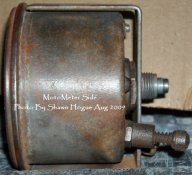 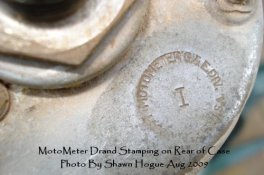
AC
The AC was not a factory fitted
speedometer and would be
incorrect for a factory restoration. They were however used in other
military
vehicles of the time such as the DUKW and were often fitted to the jeep
by
service personnel as a replacement. The AC was used as a replacement
for the
non-incremented slat grill speedometers. They are therefore correct for
a motor
pool class restoration.
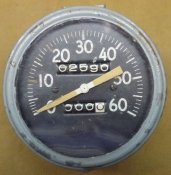 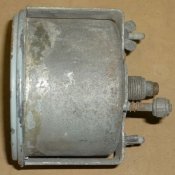 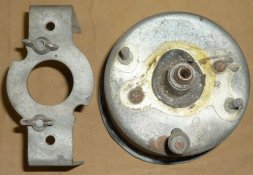
Early Long needle AC speedo 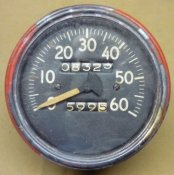 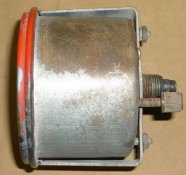 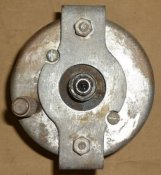
Late Short Needle AC Speedo
MB
GAUGES
The MB gauges have a more rounded
steel bezel than the
square GPW ones. The early and mid 1942 gauges had rubber seals and
from late
1942 to end of production cork and paper seals were used due to the
rubber
shortage.
Contrary to what some believe the
Slat Grill MB did not
have brass bezel gauges.
GAS & FUEL
GAUGES
There are two types of MB fuel
gauge. The first gauge has
Gas printed at the bottom of the face
and was used in the early slat grill MB. The second
type
was used in all
MB’s after the slat grill and has Fuel printed at the bottom of the
face. Both
types have a pointed needle and E ¼ ½ ¾ F
printed on the face. 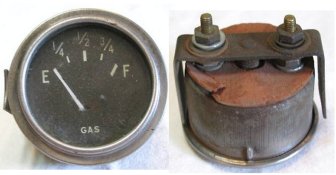
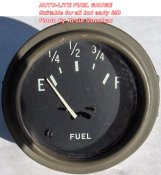 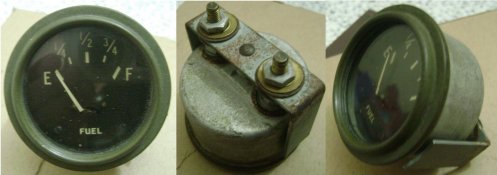
AMPERES
GAUGE
There are two types of amperes
gauge. The first type is a
30-15-0-15-30 gauge and was used in the slat grill MB. The second type is a
50-25-0-25-50
type and was used in all MB’s including the slat grill from Jan. 42
onwards.
Both gauges have a thin pointed needle.
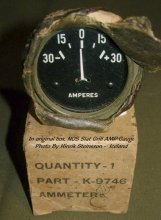 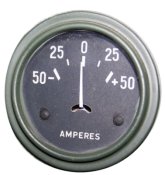
OIL
GAUGE
The oil gauge is a 0 to 80 psi
gauge and has a thin
pointed needle. Variations include larger attaching studs and bracket for Slat Grill jeeps.
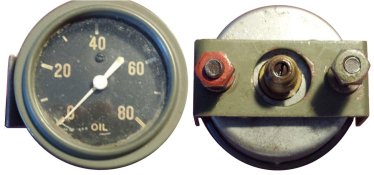 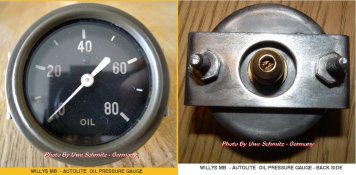
TEMPERATURE
GAUGE
The temperature gauge is a 100 to
220 deg. Gauge and has a
thin pointed needle. The binding for the capillary tube for an MB is a coil spring wire.
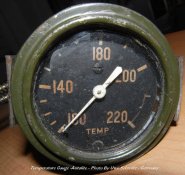 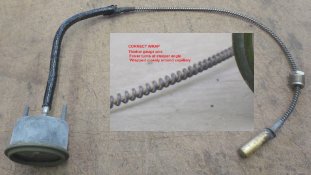 
TM 9-1829A Manual on Speedometers Tachometers and Recorders
JeepDraw Back to the Parts_Colours Page g503.com
|



































 The Autolite speedo was used in the
Slat Grill MB
only
The Autolite speedo was used in the
Slat Grill MB
only






















